Vasorelaxant Effect and Blood Pressure Reduction Potential of Pitaya Juice Concentrate (Stenocereus huastecorum) Associated with Calcium Channel Blockade
Abstract
1. Introduction
2. Materials and Methods
2.1. Reagents
2.2. Isolation of PJC
2.3. Guide for Use and Care of the Experimental Model
2.4. Ex Vivo: Measurement of the Vasoactive Response
2.4.1. Experimental Protocol
2.4.2. Isolation of Smooth Muscle Cells from the Thoracic Aorta and Mesenteric Artery for Patch-Clamp Recording
2.4.3. Electrophysiological Recordings
2.5. In Vivo Studies: Measurement of the Vasoactive Response
2.5.1. Experimental Protocols
2.5.2. PJC Effect in SHR and WKY Rats
2.6. Phytochemical Analysis
2.6.1. PJC Fractionation
2.6.2. Bioactive Compounds Profiling by High-Performance Liquid Chromatography Equipped with a Diode Array Detector (HPLC-PDA)
2.6.3. Characterization by UV-Vis Spectroscopy
2.6.4. NMR Analysis of PJC and F1
2.7. Statistical Analyses
3. Results
3.1. PJC-Induced Relaxation of Isolated Thoracic Aortic Rings
3.2. Role of the Endothelium in the Vascular Response to PJC
3.3. Role of K+ Channel in the Vascular Response to PJC
3.4. Role of Cav Channels in the Vascular Response to PJC
3.5. PJC Fractions Relaxed Isolated Thoracic Aorta and Mesenteric Artery Rings
3.6. Cav Channels in the Vascular Response To F1 from PJC
3.7. PJC Induces Antihypertensive Effects in SHRs
3.8. PJC and F1 Profiling
3.9. Characterization of PJC and F1 by UV-Vis Spectroscopy
3.10. NMR Analysis of F1
4. Discussion
5. Conclusions
6. Study Limitations
Supplementary Materials
Author Contributions
Funding
Institutional Review Board Statement
Informed Consent Statement
Data Availability Statement
Acknowledgments
Conflicts of Interest
Abbreviations
References
- Organización Mundial de la Salud Enfermedades Cardiovasculares. Available online: https://www.who.int/cardiovascular_diseases/about_cvd/es/ (accessed on 6 July 2022).
- Secretaría de Salud. En México, Más de 30 Millones de Personas Padecen Hipertensión Arterial: Secretaría de Salud. Available online: https://www.gob.mx/salud/articulos/en-mexico-mas-de-30-millones-de-personas-padecen-hipertension-arterial-secretaria-de-salud (accessed on 6 July 2022).
- American Heart Association Hypertension. Available online: https://www.heart.org/en/health-topics/high-blood-pressure/the-facts-about-high-blood-pressure (accessed on 6 July 2022).
- Gerard, J.; Tortora, B.D. Principios de Anatomía y Fisiología, 13th ed.; Editorial Médica Panamericana: Hoboken, NJ, USA, 2013; ISBN 978-6077743781. [Google Scholar]
- Prasad, K. Structure and Function of Various Vascular Beds. In Textbook of Angiology; Springer: New York, NY, USA, 2000; pp. 3–10. [Google Scholar] [CrossRef]
- Aiello, E.A. Canales de Potasio (K+) y Calcio (Ca2+) En Musculo Liso Vascular. Hipertensión Arterial, Epidemiología, Fisiología, Fisiopatología, Diagnóstico y Terapéutica; Editorial Intermédica: Buenos AiresArgentina, Argentina, 2015; pp. 87–92. [Google Scholar]
- Lahera, V.; Cachofeiro, V.; de las Heras, N. Regulación de La Presión Arterial. In Fisiología Humana, 4th ed.; Fernández-Tresguerres, J.A., Ruiz, C.A., Cachofeiro, V., Cardinali, D.P., Escriche, E.E., Gil-Loyzaga, P.E., Juliá, V.L., Teruel, F.M., Pardo, M.R., Menéndez, J.T., Eds.; McGraw-Hill Education: New York, NY, USA, 2016. [Google Scholar]
- Vergara-Galicia, J.; Ortiz-andrade, R.; Rivera-leyva, J.; Castillo-españa, P.; Villalobos-molina, R.; Ibarra-barajas, M.; Gallardo-ortiz, I.; Estrada-soto, S. Vasorelaxant and Antihypertensive Effects of Methanolic Extract from Roots of Laelia Anceps Are Mediated by Calcium-Channel Antagonism. Fitoterapia 2010, 81, 350–357. [Google Scholar] [CrossRef] [PubMed]
- Wolak, T.; Paran, E. Can Carotenoids Attenuate Vascular Aging? Vascul. Pharmacol. 2013, 59, 63–66. [Google Scholar] [CrossRef] [PubMed]
- Correa, S.; Puebla, P.; Carrón, R.; Martín, M.; San Román, L.; Guerrero, M. Perfil Vasodilatador de Comuestos Flavonoides y Fenilbutanoides Aislados de Croton Shiedeanus Schlecht. Investig. Orig. 2008, 56, 291–301. [Google Scholar]
- Potenza, M.; Marasciulo, F.; Tarquinio, M.; Tiravanti, E.; Colantuono, G.; Federici, A.; Kim, J.; Quon, M.J.; Montagnani, M. EGCG, a Green Tea Polyphenol, Improves Endothelial Function and Insulin Sensitivity, Reduces Blood Pressure, and Protects against Myocardial I/R Injury in SHR. Am. J. Physiol. Metab. 2019, 229, 1378–1387. [Google Scholar] [CrossRef] [PubMed]
- Coles, L.T.; Clifton, P.M. Effect of Beetroot Juice on Lowering Blood Pressure in Free-Living, Disease-Free Adults: A Randomized, Placebo-Controlled Trial. Nutr. J. 2012, 11, 106. [Google Scholar] [CrossRef] [PubMed]
- García-Cruz, L.; Salinas-Moreno, Y.; Valle-Guadarrama, S. Betalains, Phenolic Compounds and Antioxidant Activity in Pitaya De Mayo (Stenocereus Griseus H.). Rev. Fitotec. Mex. 2012, 35, 1–5. [Google Scholar] [CrossRef]
- García-Cruz, L.; Dueñas, M.; Santos-Buelgas, C.; Valle-Guadarrama, S.; Salinas-Moreno, Y. Betalains and Phenolic Compounds Profiling and Antioxidant Capacity of Pitaya (Stenocereus Spp.) Fruit from Two Species (S. pruinosus and S. stellatus). Food Chem. 2017, 234, 111–118. [Google Scholar] [CrossRef]
- Ramírez-Rodríguez, Y.; Ramírez, V.; Robledo-Márquez, K.; García-Rojas, N.; Rojas-Morales, P.; Arango, N.; Pedraza-Chaverri, J.; Medina-Campos, O.N.; Pérez-Rojas, J.M.; Flores-Ramírez, R.; et al. Stenocereus Huastecorum-Fruit Juice Concentrate Protects against Cisplatin-Induced Nephrotoxicity by Nitric Oxide Pathway Activity and Antioxidant and Antiapoptotic Effects. Food Res. Int. 2022, 160, 111337. [Google Scholar] [CrossRef]
- Murphy, R.A. Contractile System Function in Mammalian Smooth Muscle. J. Vasc. Res. 1976, 13, 1–23. [Google Scholar] [CrossRef]
- Holzenberger, M.; Dumanois-Le Tan, V.; Ayer-Lelièvre, C.; Vincent, M.; Safar, M.; Renaud, J.F. [Two Strains of Genetically Hypertensive Rats, LH and SRH, Have Distinct Profiles of Postnatal Expression of Tropoelastin and Type III Collagen in the Aortic Wall]. Arch. Mal. Coeur Vaiss. 1996, 89, 991–996. [Google Scholar]
- Baldassano, S.B.; Esoriere, L.T.; Otondo, A.R.; Erio, R.S.; Ivrea, M.A.L. Inhibition of the Mechanical Activity of Mouse Ileum by Cactus Pear (Opuntia Ficus Indica, L, Mill.) Fruit Extract and Its Pigment Indicaxanthin. Química Aliment. Agrícola 2010, 58, 7565–7571. [Google Scholar] [CrossRef] [PubMed]
- Esquivel-Gutiérrez, E.R.; Noriega-cisneros, R.; Bello-gonzález, M.A.; Saavedra-, A. Plantas Utilizadas En La Medicina Tradicional Mexicana Con Propiedades Antidiabéticas y Antihipertensivas. Biológicas 2012, 14, 42–52. [Google Scholar]
- Ramírez-Rodríguez, Y.; Martínez-Huélamo, M.; Pedraza-Chaverri, J.; Ramírez, V.; Martínez-Tagüeña, N.; Trujillo, J. Ethnobotanical, Nutritional and Medicinal Properties of Mexican Drylands Cactaceae Fruits: Recent Findings and Research Opportunities. Food Chem. 2020, 312, 126073. [Google Scholar] [CrossRef] [PubMed]
- Sarr, M.; Ngom, S.; Kane, M.O.; Wele, A.; Diop, D.; Sarr, B.; Gueye, L.; Andriantsitohaina, R.; Diallo, A.S. In Vitro Vasorelaxation Mechanisms of Bioactive Compounds Extracted from Hibiscus Sabdariffa on Rat Thoracic Aorta. Nutr. Metab. 2009, 6, 45. [Google Scholar] [CrossRef] [PubMed]
- Hadipour, E.; Taleghani, A.; Tayarani-Najaran, N.; Tayarani-Najaran, Z. Biological Effects of Red Beetroot and Betalains: A Review. Phyther. Res. 2020, 34, 1847–1867. [Google Scholar] [CrossRef]
- Aekthammarat, D.; Tangsucharit, P.; Pannangpetch, P.; Sriwantana, T.; Sibmooh, N. Moringa Oleifera Leaf Extract Enhances Endothelial Nitric Oxide Production Leading to Relaxation of Resistance Artery and Lowering of Arterial Blood Pressure. Biomed. Pharmacother. 2020, 130, 110605. [Google Scholar] [CrossRef]
- Gilani, A.H.; Khan, A.; Jabeen, Q.; Subhan, F.; Ghafar, R. Antispasmodic and Blood Pressure Lowering Effects of Valeriana Wallichii Are Mediated through K+ Channel Activation. J. Ethnopharmacol. 2005, 100, 347–352. [Google Scholar] [CrossRef] [PubMed]
- Xie, H.; Zhang, X.; Chen, Y.; Shen, F.; Su, D. Synergism of Hydrochlorothiazide and Nifedipine on Blood Pressure Variability Reduction and Organ Protection in Spontaneously Hypertensive Rats. Hypertens. Res. 2008, 31, 685–691. [Google Scholar] [CrossRef][Green Version]
- Sonkusare, S.; Palade, P.T.; Marsh, J.D.; Telemaque, S.; Rusch, N.J.; Sciences, M.; States, U.; Rock, L.; States, U. Vascular Calcium Channels and High Blood Pressure: Pathophysiology and Therapeutic Implications. Vasc. Pharmacol. 2016, 44, 131–142. [Google Scholar] [CrossRef]
- Bhullar, S.K.; Shah, A.K.; Dhalla, N.S. Store-Operated Calcium Channels: Potential Target for the Therapy of Hypertension. Rev. Cardiovasc. Med. 2019, 20, 139–151. [Google Scholar] [CrossRef]
- Alsayed, A.M.; Zhang, B.L.; Bredeloux, P.; Boudesocque-Delaye, L.; Yu, A.; Peineau, N.; Enguehard-Gueiffier, C.; Ahmed, E.M.; Pasqualin, C.; Maupoil, V. Nutrients Aqueous Fraction from Hibiscus Sabdariffa Relaxes Mesenteric Arteries of Normotensive and Hypertensive Rats through Calcium Current. Nutrients 2020, 12, 1782. [Google Scholar] [CrossRef] [PubMed]
- Belović, M.M.; Gironés-Vilaplana, A.; Moreno, D.A.; Milovanović, I.L.J.; Novaković, A.R.; Karaman, M.A.; Ilić, N.M. Tomato (Solanum lycopersicum L.) Processing Main Product (Juice) and By-Product (Pomace) Bioactivity Potential Measured as Antioxidant Activity and Angiotensin-Converting Enzyme Inhibition. J. Food Process. Preserv. 2016, 40, 1229–1237. [Google Scholar] [CrossRef]
- Prieto, D.; Benedito, S.; Nyborg, N.C.B. Heterogeneous Involvement of Endothelium in Calcitonin Gene-related Peptide-induced Relaxation in Coronary Arteries from Rat. Br. J. Pharmacol. 1991, 103, 1764–1768. [Google Scholar] [CrossRef] [PubMed]
- Pereira-Gonçalves, Á.; Ferreira-da-Silva, F.W.; de Holanda-Angelin-Alves, C.M.; Cardoso-Teixeira, A.C.; Coelho-de-Souza, A.N.; Leal-Cardoso, J.H. 1,8-Cineole Blocks Voltage-Gated L-Type Calcium Channels in Tracheal Smooth Muscle. Pflugers Arch. Eur. J. Physiol. 2018, 470, 1803–1813. [Google Scholar] [CrossRef] [PubMed]
- Brito, S.D.R.; Barber Fox, M.O.; Gutiérrez, E.B. Volemia y Excreción Urinaria En Ratas Hipertensas Tratadas Con Nifedipina o Diuréticos. Rev. Cuba. Investig. Biomed. 2001, 20, 99–103. [Google Scholar]
- Rakusan, K.; Cicutti, N.; Kazda, S.; Turek, Z. Effect of Nifedipine on Coronary Capillary Geometry in Normotensive and Hypertensive Rats. Hypertension 1994, 24, 205–211. [Google Scholar] [CrossRef]
- García-cruz, L.; Valle-guadarrama, S.; Salinas-moreno, Y.; Luna-morales, C. Postharvest Quality, Soluble Phenols, Betalains Content, and Antioxidant Activity of Stenocereus Pruinosus and Stenocereus Stellatus Fruit. Postharvest Biol. Technol. 2016, 111, 69–76. [Google Scholar] [CrossRef]
- Castro-Enriquez, D.; Montaño-Leyva, B.; Toro-Sánchez, C.; Juárez-Onofre, J.; Carvajal-Millán, E.; López-Ahumada, G.; Barreras-Urbina, C.; Tapia-Hernández, J.; Rodríguez-Féliz, F. Effect of Ultrafiltration of Pitaya Extract (Stenocereus thurberi) on Its Phytochemical Content, Antioxidant Capacity, and UPLC-DAD-MS Profile Daniela. Molecules 2020, 25, 281. [Google Scholar] [CrossRef]
- Bautista, E.; Fragoso-serrano, M.; Pereda-miranda, R. Jalapinoside, a Macrocyclic Bisdesmoside from the Resin Glycosides of Ipomea Purga, as a Modulator of Multidrug Resistance in Human Cancer Cells. Nat. Prod. Res. 2015, 78, 168–172. [Google Scholar] [CrossRef] [PubMed]
- Moreno-Velasco, A.; Fragoso-Serrano, M.; de Jesús Flores-Tafoya, P.; Carrillo-Rojas, S.; Bautista, E.; Leitão, S.G.; Castañeda-Gómez, J.F.; Pereda-Miranda, R. Inhibition of Multidrug-Resistant MCF-7 Breast Cancer Cells with Combinations of Clinical Drugs and Resin Glycosides from Operculina Hamiltonii. Phytochemistry 2024, 217, 113922. [Google Scholar] [CrossRef]
- Pereda-Miranda, R.; Castañeda-Gómez, J.F.; Fragoso-Serrano, M. Recycling Preparative Liquid Chromatography, the Overlooked Methodology for the Purification of Natural Products. Rev. Bras. Farmacogn. 2024, 1–21. [Google Scholar] [CrossRef]
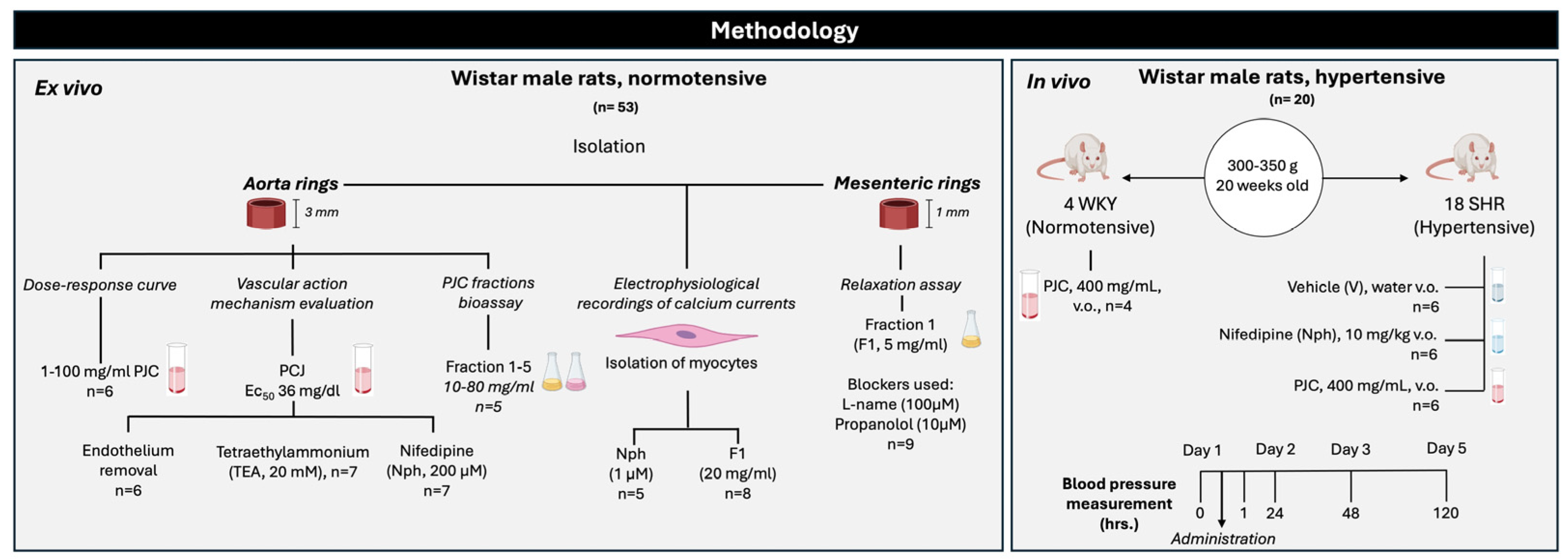

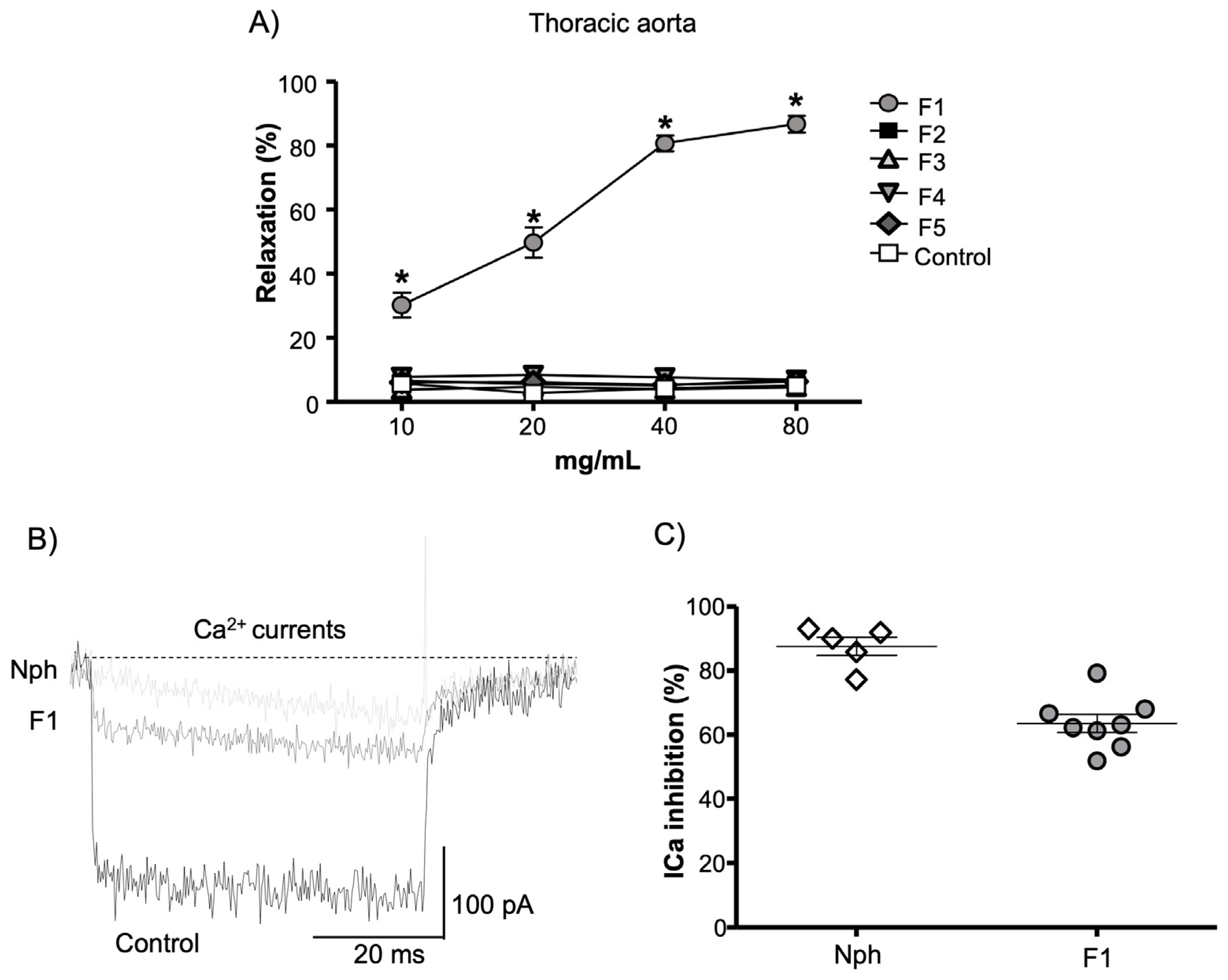

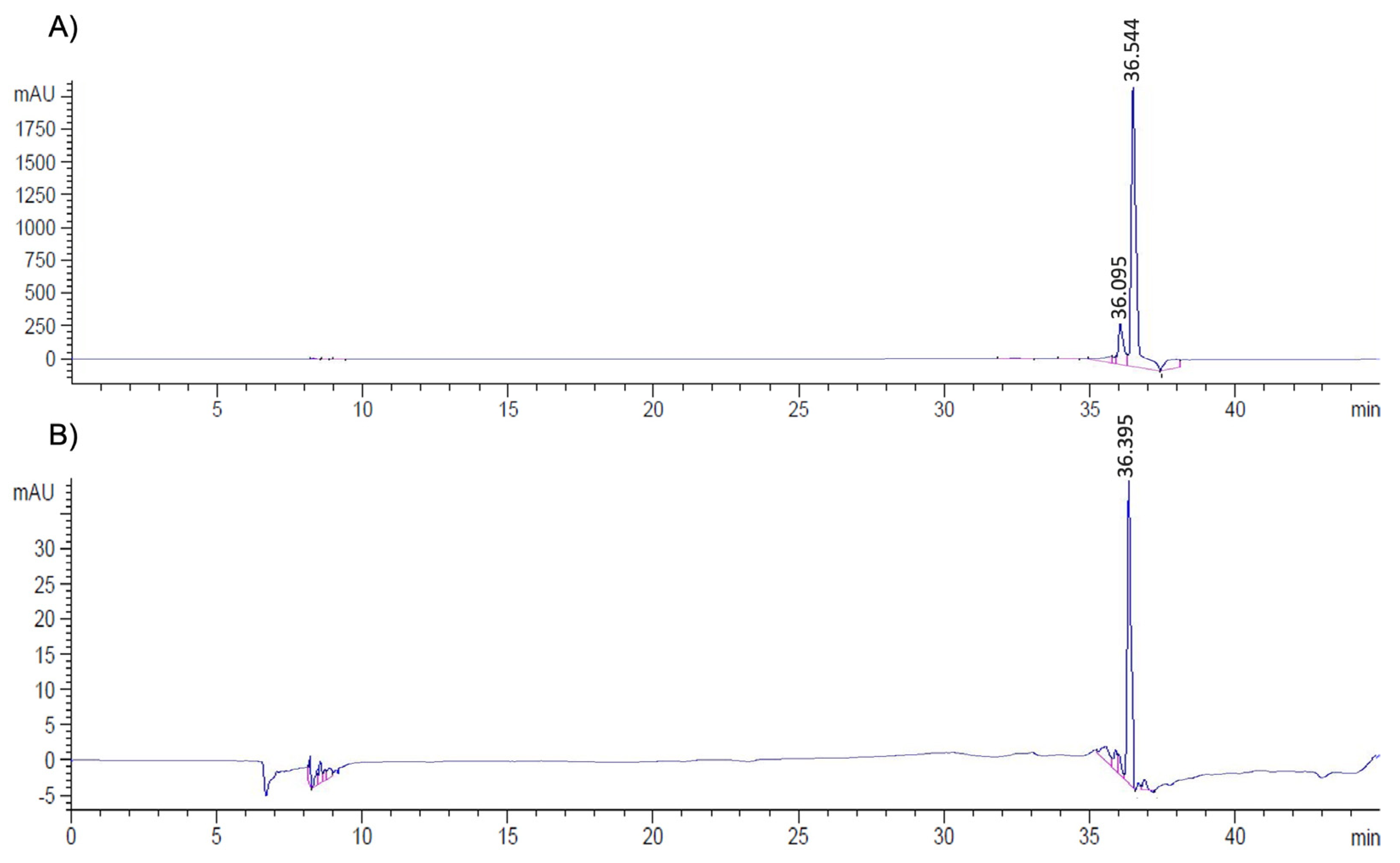
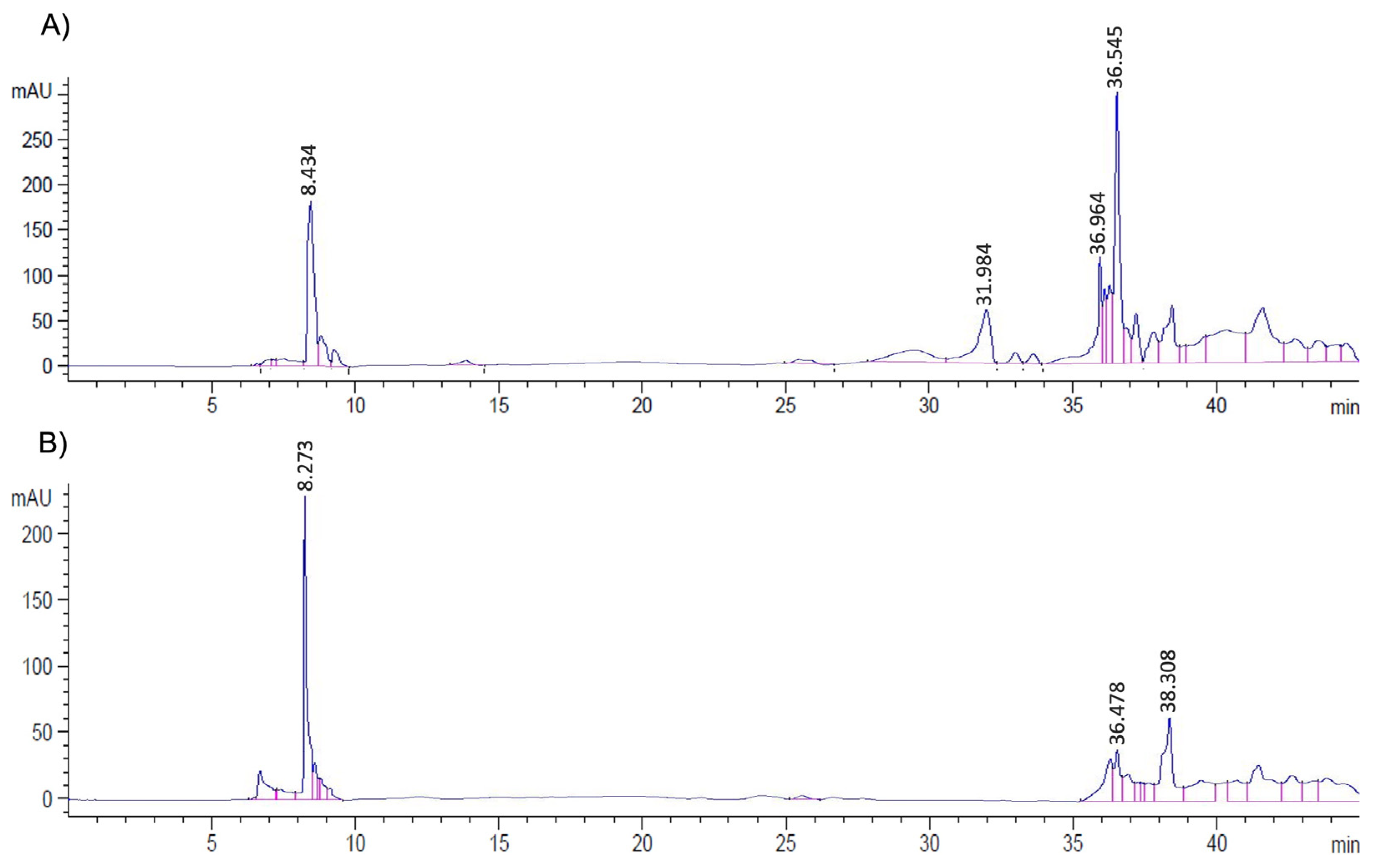
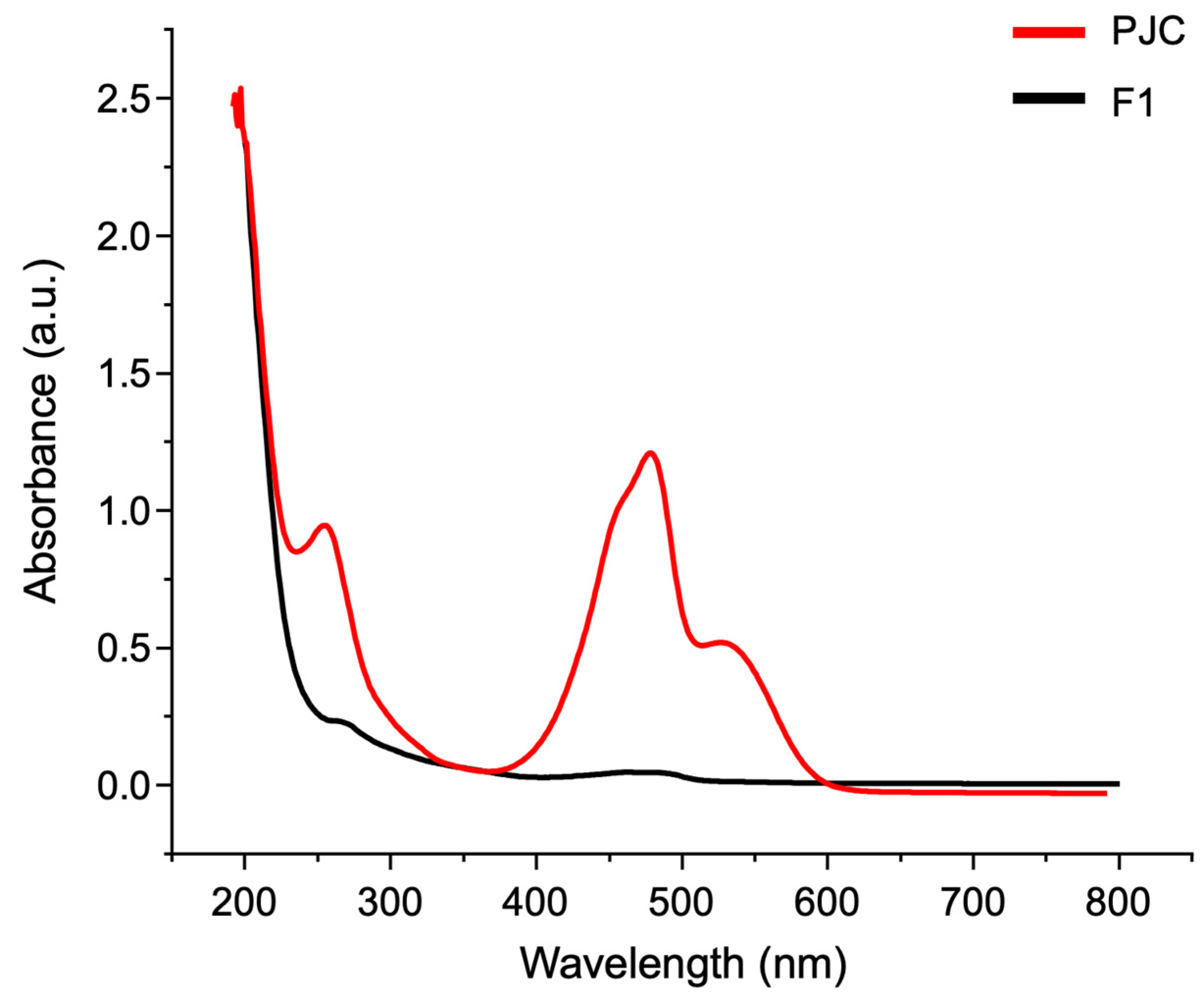
Disclaimer/Publisher’s Note: The statements, opinions and data contained in all publications are solely those of the individual author(s) and contributor(s) and not of MDPI and/or the editor(s). MDPI and/or the editor(s) disclaim responsibility for any injury to people or property resulting from any ideas, methods, instructions or products referred to in the content. |
© 2024 by the authors. Licensee MDPI, Basel, Switzerland. This article is an open access article distributed under the terms and conditions of the Creative Commons Attribution (CC BY) license (https://creativecommons.org/licenses/by/4.0/).
Share and Cite
Ramírez-Rodríguez, Y.; Espinosa-Tanguma, R.; Valle-Aguilera, J.R.; Rodríguez-Menchaca, A.A.; Saderi, N.; Salgado-Delgado, R.; Bautista, E.; Garcés, L.; Ramírez, V.; Robledo-Márquez, K.; et al. Vasorelaxant Effect and Blood Pressure Reduction Potential of Pitaya Juice Concentrate (Stenocereus huastecorum) Associated with Calcium Channel Blockade. Foods 2024, 13, 2631. https://doi.org/10.3390/foods13162631
Ramírez-Rodríguez Y, Espinosa-Tanguma R, Valle-Aguilera JR, Rodríguez-Menchaca AA, Saderi N, Salgado-Delgado R, Bautista E, Garcés L, Ramírez V, Robledo-Márquez K, et al. Vasorelaxant Effect and Blood Pressure Reduction Potential of Pitaya Juice Concentrate (Stenocereus huastecorum) Associated with Calcium Channel Blockade. Foods. 2024; 13(16):2631. https://doi.org/10.3390/foods13162631
Chicago/Turabian StyleRamírez-Rodríguez, Yadira, Ricardo Espinosa-Tanguma, Juan Roberto Valle-Aguilera, Aldo A. Rodríguez-Menchaca, Nadia Saderi, Roberto Salgado-Delgado, Elihú Bautista, Luis Garcés, Victoria Ramírez, Karina Robledo-Márquez, and et al. 2024. "Vasorelaxant Effect and Blood Pressure Reduction Potential of Pitaya Juice Concentrate (Stenocereus huastecorum) Associated with Calcium Channel Blockade" Foods 13, no. 16: 2631. https://doi.org/10.3390/foods13162631
APA StyleRamírez-Rodríguez, Y., Espinosa-Tanguma, R., Valle-Aguilera, J. R., Rodríguez-Menchaca, A. A., Saderi, N., Salgado-Delgado, R., Bautista, E., Garcés, L., Ramírez, V., Robledo-Márquez, K., Riego-Ruiz, L., & Trujillo, J. (2024). Vasorelaxant Effect and Blood Pressure Reduction Potential of Pitaya Juice Concentrate (Stenocereus huastecorum) Associated with Calcium Channel Blockade. Foods, 13(16), 2631. https://doi.org/10.3390/foods13162631







